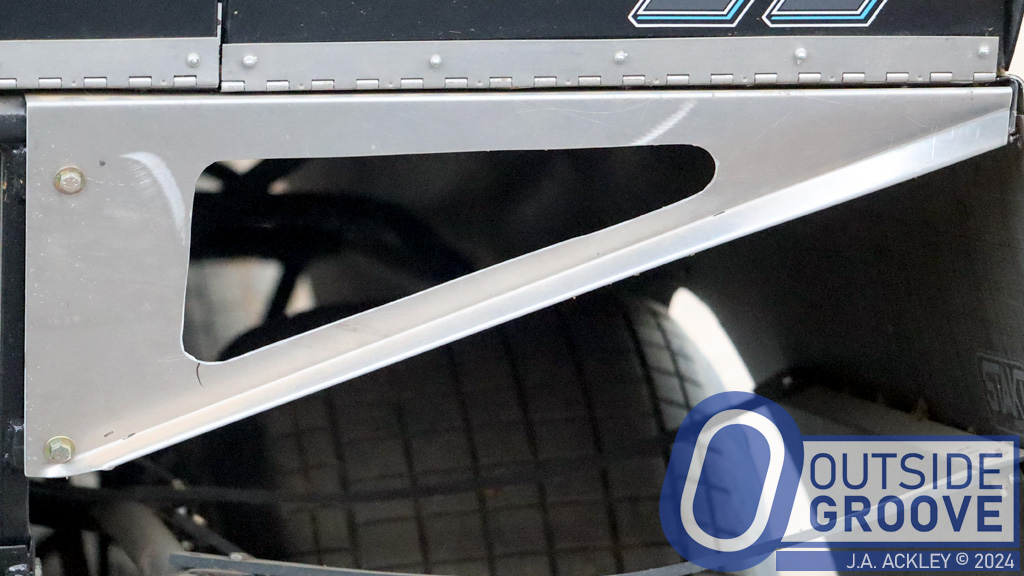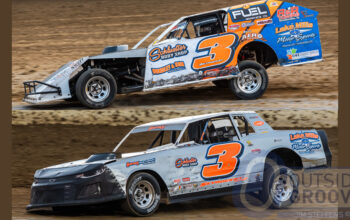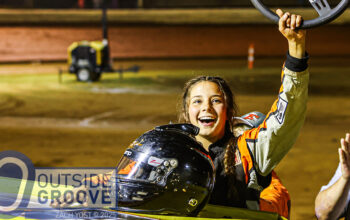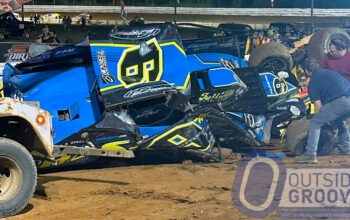The T-bar breakaways on the rear of dirt cars have become a hot topic. Not so much the breakaways themselves, but the way racers attach them to their cars. Kankakee County Speedway now requires its teams to bolt them to their cars or tether them.
“Riveting them on is the problem, with cars clipping the wall, the rivets are broken or knocked out and the breakaway ends up on the racetrack,” said Billy Knippenberg, promoter of Kankakee County Speedway in Illinois. “We can’t have pieces of metal on the racetrack — it’s very dangerous. A breakaway could be propelled into another driver’s cockpit or go over the fence and hurt people.”
Knippenberg added that of the 10 cautions the modified feature had last weekend at Kankakee, seven were the result of breakaway debris. Companies that make the breakaways, such as Allstar Performance, agree that they need to be secured appropriately.
“I recommend bolting [the breakaway] to the upright bars and using rivets across the top of the breakaway,” said Allstar Performance’s Curt Spalding, who also races dirt modifieds. “The goal is to keep the part on the car, and a couple of ¼″ bolts will do that. The breakaway is made to keep the deck on top of the T-bar in a collision. It creates a crush zone.”
Daniel Sanchez, another dirt modified racer, works with Five Star Race Car Bodies. He bolts his breakaways with two ¼″-20 bolts with locknuts.
“I bolt the bracket to the right-side T-bar,” Sanchez said. “That’s all it takes to keep the breakaway intact — and it still does what it is meant to do. Yet, I see them fall off of cars on the track all the time.”
Champ Pans by JR Manufacturing, Inc. produces breakaways as well. The company’s Jesse Redetzke, a super stock driver, designed the breakaways.
“This part began as a driver safety item and now it has gotten attention as a safety concern, which is unfortunate,” Redetzke said. “Rivets break too easily, whether they are aluminum or have a steel nail. I recommend mounting the breakaway with ¼″ fender bolts that have washers attached to them. My breakaways are made from 1/8″ aluminum. If you hit the wall, they just bend and stay attached to the car.”
Redetzke said breakaways started when a driver slammed against a wall and the impact drove a piece of square tubing from the deck support through his arm.
“The driver showed me where the tubing went through his bicep — it took a square piece out of his arm,” said Redetzke.
Knippenberg hopes the measures they are taking at Kankakee County Speedway catch on elsewhere.
“It is a safety issue if even one breakaway falls off,” Knippenberg said. “I also know fans don’t want to see a feature with constant cautions. I hope others jump on board to inspect breakaways and make sure they have two bolts to keep them from flying off of cars.”
Mike Adaskaveg has written hundreds of stories since the website’s inception. This year marks his 54th year of covering auto racing. Adaskaveg got his start working for track photographer Lloyd Burnham at Connecticut’s Stafford Motor Speedway in 1970. Since then, he’s been a columnist, writer, and photographer, in racing and in mainstream media, for several outlets, including the Journal Inquirer, Boston Herald, Stock Car Racing, and Speedway Illustrated. Among Adaskaveg’s many awards are the 1992 Eastern Motorsport Press Association (EMPA) Ace Lane Photographer of the Year and the 2019 National Motorsports Press Association (NMPA) George Cunningham Writer of the Year.





